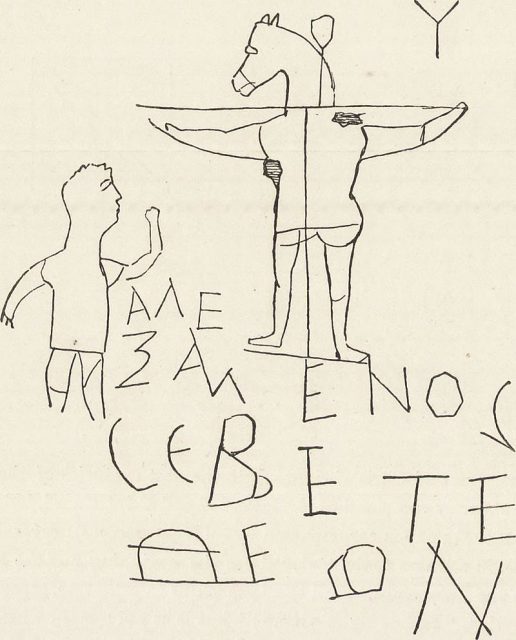
The earliest example we have of a picture of Christ (the picture above) is not of Him on the cross, but Him as a shepherd. (The eariliest picture of Jesus on a cross is actually one done in mockery, depicting Jesus as an “asenos” (donkey) on the cross.)

What is the basis for this focus, this emphasis on Him as shepherd? The specific references to Him as Shepherd in the Gospels come from two sources, John 10 and Luke 15. The former is the classic “Good Shepherd” chapter, and the latter is the parable about the man who leaves the 99 sheep behind to find the one lost lamb. “And when he has found it, he lays it on his shoulders, rejoicing.” Arguably the Parable of the Sheep and the Goats from Matthew 25 presents Jesus as the Shepherd, even if not specifically invoking the image.
Two epistle writers reference the image as well. Hebrews says, “Now may the God of peace who brought up our Lord Jesus from the dead, that great Shepherd of the sheep, through the blood of the everlasting covenant.” And Peter has two references in his first epistle, “For you were like sheep going astray, but have now returned to the Shepherd and Overseer of your souls. … and when the Chief Shepherd appears, you will receive the crown of glory that does not fade away.”
Finally, the Revelation uses the image: “The Lamb who is in the midst of the throne will shepherd them and lead them to living fountains of waters. And God will wipe away every tear from their eyes.”
Of course these images evoke the beloved Psalm, “The LORD is my shepherd; I shall not want. He makes me to lie down in green pastures.”
Here we see a strong indication that the apostolic church understood the Lord Jesus as truly “The LORD,” that is Jehovah. They understood Jesus as Lord God, the Son of God, of one substance with the Father.
We also see the basis for another powerful allusion to the image, in the words, “He makes me to lie down in green pastures.” For in the Laetare Gospel, we hear that Jesus said, “Make the people sit down.” We also learn, “Now there was much grass in the place.”
Jesus literally made the people to lie down, or sit down, in green pastures. And lest we doubt the grass was green, the Gospel of Mark fills in the detail. “He commanded them to make them all sit down in groups on the green grass.”
Clearly the apostolic writers recognized in the feeding of the 5,000 the revelation of Jesus as the fulfillment of Psalm 23. And if the image of Christ the Shepherd is right up there with Christ the Crucified or Christ the Resurrected Victor, it’s probably related to the fact that this miracle is one of the few events in Christ’s life (in addition to the baptism, crucifixion, and resurrection) that is featured in all four Gospels.
Again, clearly the event was pivotal in the hearts of the faithful in the early Church. Yes, it was as pivotal and central as the eucharist was pivotal and central to their worship. For clearly the feeding of the 5,000 is an image of Holy Communion. It’s Jesus’ feeding of His flock in the midst of a desert. Well, how does Jesus feed us with His miraculous meal as we sojourn in the wilderness of this world? That Jesus immediately after the feeding in John 6 goes on to teach, “Whoever eats my flesh and drinks my blood has eternal life” – actually explaining explicitly what His purpose is in the feeding – underscores the sacramental connection.
And then we have the sequence of verbs in the accounts. As the Matthew account has it: “And He took the five loaves…He blessed and broke and gave the loaves to the disciples.” Took, blessed (or gave thanks), broke, and gave. That’s the language of the Last Supper as well.
So Holy Communion is our wilderness feeding, where our “great Shepherd of the sheep” works among us “through the blood of the everlasting covenant,” that is, the “new testament” in His blood, the blood that speaks better things than that of Abel (not revenge, but forgiveness).
In this image of the Good Shepherd, there are no fuzzy lines where God ends and we begin, as there are in non-sacramental understandings of the Gospel. Jesus is the Good Shepherd doing all the work of grace. And us? We are made to sit in the green grasses, being fed. The sent ones (apostles) do the work of distribution, laying the foundation for all ministers thereafter.
And actually, as we find out at the end of the Gospel, things go awry when the people make their own conclusions and get involved in the action, hoping to institutionalize the moment politically. Wrong answer!
The right answer is, be the sheep. Be found. Be made to sit down in the grass, in the green pastures. Be fed.